Whether you’ve seen the movie or not, one of the things that were most surprising about Avatar is the glowing plants that could be found all over the world of Pandora. Similar plants could soon be found on Earth, thanks to a new study.

Scientists found that it’s actually possible to create plants that produce their own visible luminescence, thanks to the fact that the bioluminescence found in some mushrooms is metabolically similar to the natural processes common among plants.
This means that the DNA obtained from the mushroom could be inserted into the plants, making them glow much brighter than previously possible, according to the group of researchers from the UK, Russia, and Austria.
The discovery could be used to create glowing flowers or other ornamental plants, and change the make-up of the plants that surround us, the team argued. It can also be used by scientists to learn more about the plants they study, watching the glow to see their inner workings.
“In the future this technology can be used to visualize activities of different hormones inside the plants over the lifetime of the plant in different tissues, absolutely non-invasively. It can also be used to monitor plant responses to various stresses and changes in the environment,” Karen Sarkisyan, lead-author, told The Guardian.
The new plants can produce more than a billion photons per minute, according to the researchers who created it. That is far brighter than any previous example, and the glow they obtained is more stable. The new findings will be commercialized soon in ornamental house plants by the companies Light Bio and Planta.
Designing new biological features is more complex than merely moving genetic parts from one organism to another, which has caused past attempts to create glowing parts to fail. All the genetic parts must metabolically integrate within the host and for most organisms the parts needed for bioluminescence are not all known.
The researchers unveiled the parts that sustain bioluminescence in mushrooms last year. Now, with the living light of an advanced multicellular organism fully defined, they were able to make glowing plants that are at least ten-fold brighter (as judging from illumination coming from leaves, roots, stems, and flowers).
Although mushrooms are not closely related to plants, the researchers discovered that the organic molecule at the center of the light emission from mushrooms is also used by plants when building cell walls, giving the scientists their opening to graft the needed genes. By dropping the DNA from the mushroom into the plants, they were able to create specimens that glowed ten times as bright, the researchers said. They are so bright that light could be seen coming from leaves, stems, roots, and flowers and captured using a normal smartphone camera, they claimed.
The researchers said that thanks to their finding even brighter plants could be developed in the future and that new features, such as changing brightness or color in response to people and surroundings could also be mixed in. But for that to happen there’s more work to be done.
“The challenge now is to figure out how to make this engineered bioluminescence responsive to specific environmental, developmental, chemical or pathogenic stimuli,” University of Cambridge professor John Carrr told The Guardian.
The study was published in the journal Nature Biotechnology.
Was this helpful?



